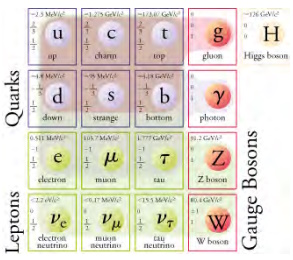The Standard Model of the atom refers to the current scientific view of the fundamental components and interacting forces of matter. The Standard Model diagram below shows the six quarks that bind to form all hadrons, the six lepton particles already considered fundamental, the four carrier particles (or gauge bosons) that transmit forces between the leptons and quarks, and the recently added Higgs boson (which will be discussed shortly). This totals 17 fundamental particles, combinations of which are responsible for all known matter in our entire universe! When adding the antiquarks and antileptons, 31 components make up the Standard Model.

The Standard Model of elementary particles shows an organized view of all fundamental particles, as currently known: six
quarks, six leptons, and four gauge bosons (or carrier particles). The Higgs boson, first observed in 2012, is a new
addition to the Standard Model.
This diagram shows all particles within the Standard Model of the atom. Not only does this chart divide all known particles by color-coded group, but it also provides information on particle stability. Note that the color-coding system in this chart is separate from the red, green, and blue color labeling system of quarks. The first three columns represent the three families of matter. The first column, considered Family 1, represents particles that make up normal matter, constructing the protons, neutrons, and electrons that make up the common world. Family 2, represented from the charm quark to the muon neutrino, is comprised of particles that are more massive. The leptons in this group are less stable and more likely to decay. Family 3, represented by the third column, are more massive still and decay more quickly. The order of these families also conveniently represents the order in which these particles were discovered.
The Standard Model also summarizes the fundamental forces that exist as particles interact. A closer look at the Standard Model, as shown below, reveals that the arrangement of carrier particles describes these interactions.

The revised Standard Model shows the interaction between gauge bosons and other fundamental particles. These
interactions are responsible for the fundamental forces, three of which are described through the chart’s shaded areas.
Each of the shaded areas represents a fundamental force and its constituent particles. The red shaded area shows all particles involved in the strong nuclear force, which we now know is due to quantum chromodynamics. The blue shaded area corresponds to the electromagnetic force, while the green shaded area corresponds to the weak nuclear force, which affects all quarks and leptons. The electromagnetic force and weak nuclear force are considered united by the electroweak force within the Standard Model. Also, because definitive evidence of the graviton is yet to be found, it is not included in the Standard Model.
The Higgs Boson
One interesting feature of the revised Standard Model shown above is that, while the gluon and photon have no mass, the Z and W bosons are very massive. What supplies these quickly moving particles with mass and not the gluons and photons? Furthermore, what causes some quarks to have more mass than others?
In the 1960s, British physicist Peter Higgs and others speculated that the W and Z bosons were actually just as massless as the gluon and photon. However, as the W and Z bosons traveled from one particle to another, they were slowed down by the presence of a Higgs field, much like a fish swimming through water. The thinking was that the existence of the Higgs field would slow down the bosons, causing them to decrease in energy and thereby transfer this energy to mass. Under this theory, all particles pass through the Higgs field, which exists throughout the universe. The gluon and photon travel through this field as well but are able to do so unaffected.
The presence of a force from the Higgs field suggests the existence of its own carrier particle, the Higgs boson. This theorized boson interacts with all particles but gluons and photons, transferring force from the Higgs field. Particles with large mass (like the top quark) are more likely to receive force from the Higgs boson.
While it is difficult to examine a field, it is somewhat simpler to find evidence of its carrier. On July 4, 2012, two groups of scientists at the LHC independently confirmed the existence of a Higgs-like particle. By examining trillions of proton-proton collisions at energies of 7 to 8 TeV, LHC scientists were able to determine the constituent particles that created the protons. In this data, scientists found a particle with similar mass, spin, parity, and interactions with other particles that matched the Higgs boson predicted decades prior. On March 13, 2013, the existence of the Higgs boson was tentatively confirmed by CERN. Peter Higgs and Francois Englert received the Nobel Prize in 2013 for the "theoretical discovery of a mechanism that contributes to our understanding of the origin and mass of subatomic particles."
Article source: OpenStax is a nonprofit educational technology initiative based at Rice University. OpenStax's mission is to improve educational access and learning for everyone. Textbooks on OpenStax's site are licensed under a Creative Commons Attribution 4.0 International License.

